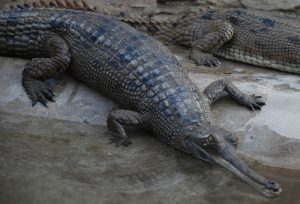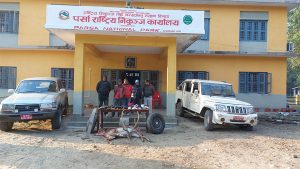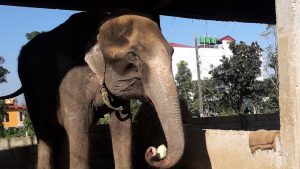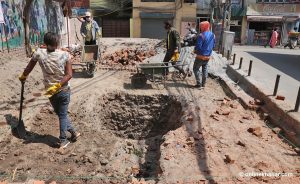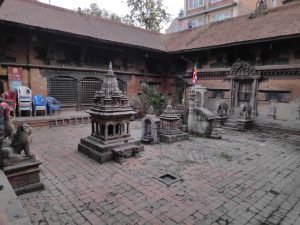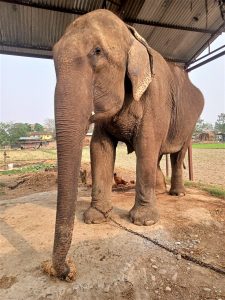
Rajendra Aryal (45) likes visiting the tourist town of Sauraha on the fringes of Chitwan National Park in Nepal. He enjoys the wilderness, the jungle safaris and the natural beauty of the place. These days, he also likes to take a dip in the swimming pools.
“Whenever I come to Sauraha with my wife and kids, I prefer to stay in a hotel with a swimming pool,” says Aryal, father of a 10-year-old son and 12-year-old daughter. “If we get the extra facility of a swimming pool without paying extra, then why not?” says Aryal, a businessman. “I bring my family over every time I have some business-related work in Chitwan.”
Like the Aryals, many Nepali tourists coming to Sauraha for their holidays these days want to stay in a hotel with swimming pools, says Rajendra Dhami, immediate past chair of Chitwan Guide Association.
Following the Covid pandemic, businesses in the tourist town on the banks of the East Rapti River have realised that domestic tourists are equally important, as they are the ones who helped them keep afloat during the pandemic years when international travel was severely affected.
“That’s the reason they want to attract domestic tourists,” says Dhami.
According to estimates by local hoteliers, around 70 per cent of the hotel room bookings in Sauraha come from domestic tourists. The estimate is also corroborated by figures from Chitwan National Park, visited by most of the tourists who go to Sauraha. Park records show that of the 190,458 tourists who visited Chitwan in the 2023-24 fiscal year, 155,671 (around 81 per cent) were Nepalis. In 2017-18 (right before the pandemic), of the 61,624 tourists who visited the park, 33,645 (around 54 per cent) were Nepali.
However, this has resulted in the proliferation of unregulated and unmonitored swimming pools in the ecologically sensitive area, home to different species of macroinvertebrates, fish and the iconic gharial crocodiles. According to the Chitwan Hotel Association, around 15-16 hotels out of the 140-odd hotels in Sauraha now boast a swimming pool. According to association president Ganga Giri, a swimming pool comes with a price tag of Rs 3-150 million (between $22,500 and $1.1 million).
A GIS-based investigation carried out by Mongabay in collaboration with the Center for Data Journalism Nepal (CDJN) found that at least two dozen hotels and resorts on the banks of the East Rapti and its tributaries have built swimming pools.
Pool of peril
During our ground reporting, we found that hotel owners extract groundwater from the banks of the river, filter it and use it to fill their pools. They then use various chemicals such as chlorine to keep the pool free from microbes.
“We don’t release the water into the river, as refilling the pool takes a lot of water and resources,” says Ram Kumar Aryal, former head of the National Trust for Nature Conservation’s Biodiversity Conservation Center and the owner of Rhino Lodge in Sauraha. “We have a system in place to filter the water and recirculate it in the swimming pool.”
Location of swimming pools in Sauraha Source: Thumbnail pool images sourced from Facebook/Google pages
Maintenance staff and technicians building pools in Sauraha also say that although the pools have outlets to drain the water, they do not do so until it is absolutely necessary, as refilling water is costly.
Ganga Giri, president of the hotel association of Chitwan and the owner of Park Safari Resort, which recently built a swimming pool on the banks of the Rapti, also echoes Aryal.
“As we need to release the water only once every 2-3 years, it’s not going to pollute the river,” says Giri.
Hotel owners say they rarely flush out all the water from a pool and the chlorine they use does not make it to the river, as it is highly reactive. But there is a possibility that chemicals used in pools do make it to the river, says Rajesh Sada, head of freshwater programs at WWF Nepal.
“At an individual level, they may be right. The amount of water they release into the river is not significant enough to cause damage. But if you look at the total number of pools, which is increasing every year, as a whole and at scale, we can say that it could become a cause for concern,” he says.
High risk of chemical pollution
Research shows that chlorine, used to kill microbes such as bacteria, viruses and other pathogens in pools, has lethal consequences.
“Freshwater species such as fish and macroinvertebrates, especially ones that don’t migrate long distances, are likely to be impacted by chlorine contamination,” says Genuine Prajapati, a researcher working on freshwater species in Nepal.
“The macroinvertebrates are a source of food for an array of fish species found in the river system,” she says.
Gharials depend on the fish for survival. If the macroinvertebrates die off or consume contaminated food, it is easily passed on to the gharials and even megafauna such as rhinos and tigers, she adds.

“The Rapti is the lifeline of Chitwan, and if anything happens to the gharials, even the rhinos and tigers won’t survive,” says conservationist and former Department of National Parks and Wildlife Conservation officer Bed Kumar Khadka.
In Nepal, local government monitoring mechanisms have been weak due to a lack of institutional capacity, and businesses have often been found to skip environmental safeguard practices.
“We don’t know if the hotel owners are actually doing what they are saying. They might be dumping water into the river without anyone knowing about it,” says local conservation activist Birendra Mahato.
Dil Bahadur Purja Pun, chief conservation officer at Chitwan National Park, says he has been unaware of the issue. “We haven’t paid attention to the issue as of now. But thank you for asking about it, we will now look into it,” he says after being asked about the issue.
Snowballing problems
Various studies have also shown one other problem with swimming pools: DBPs (disinfectant by-products), which are not only carcinogenic to humans, but also lethal for plants and animals of all shapes and sizes.
According to the U.S. Centers for Disease Control and Prevention, DBPs are formed when disinfectants such as chlorine interact with natural organic materials in water in places such as chlorine-treated swimming pools. The organic materials can come from swimmers wearing different types of lotions or sunscreen and form DBPs such as trihalomethanes and halogenated acetic acids. These compounds have been shown to be very toxic to aquatic organisms.
But neither the local government nor the hotels have done any research on DBPs and their pervasiveness in swimming pools across Chitwan, already grappling with heavy metal contamination.
Freshwater expert Subodh Sharma from Kathmandu University says the water in the Rapti could already be contaminated with different traces of heavy metals found in pesticides and fertilizers.
“Although we don’t have evidence to support this, we believe that the recent spate of deaths of rhinos in Chitwan could be due to the contamination of both river and groundwater in Sauraha,” he says. Heavy metal contamination has also been reported in several rivers in India.
In that context, as the hotel owners are using groundwater to fill pools, questions arise about the quality of water being used, he adds. “The groundwater from the Rapti could also very well be contaminating the swimming pools,” adds Sharma, who plans to look at heavy metal contamination in the Rapti in his future research.

Some industry insiders observing the situation say they think the proliferation of swimming pools in Chitwan brings to the surface a much more severe underlying problem facing the tourism business in Nepal.
Tourism entrepreneur Marcus Cotton, who runs Tiger Mountain hotels and resorts in Chitwan and Pokhara says that most people in Nepal’s tourism business generally lack the insight, understanding and thoughtfulness about their industry. “I think the wider issue is [that] the failure of the industry to embrace sustainability in their own best interests shows very limited awareness, understanding and commitment.”
The proliferation of swimming pools in Sauraha is an example of the “clone mentality” prevalent among hoteliers, he says. Cotton further adds that building a pool does not guarantee the hotel’s business will automatically grow.
“Don’t build a pool and tell the story why with enthusiastic commitment. If taking on a hotel with a pool, opt for chlorine-free sanitisation; e.g., salt, again tell the story and focus on a range of deeper, more immersive (no pun intended!) experiences instead of pools. Consider a wild swimming pool…..with free python or cobra,” he says in an email interview.
Even the existing pools are not being used to their optimum, hotel owners say. Giri, the president of the hotel association, says that only Indian and Nepali tourists frequent the pool, not to take a dip, but to take selfies. Western tourists are least bothered about the pool, he says.
That raises a question: Why waste so much water and invest resources in pools in an ecologically sensitive area when it has limited utility? asks Mahato.
“The national park doesn’t allow Musahars and Tharus to fish in their own rivers, but it allows hotels to do whatever they please even if their activities put the lifeline of the park supporting endangered species at risk,” he says.
Although Nepal’s national parks have been hailed as a success story for helping recover populations of endangered species such as rhinos and tigers, the success comes at the cost of local Indigenous people’s rights to resources and traditional livelihoods, critics have been saying.
“Local communities also feel that while their access to resources is limited, big businesses and hotels have the access and power to do whatever they want,” Mahato says.
The hotels need to understand that tourists come to Sauraha to see rhinos and tigers, and that’s keeping their businesses afloat, he adds. “But if the river gets polluted, there will be no tigers and rhinos left, and no one will come to Sauraha to keep their businesses running.”
This story first appeared on Mongabay and Onlinekhabar is republishing it under a Creative Commons licence.
This story was produced under an Earth Journalism Network (EJN) fellowship in collaboration with Centre for Data Journalism Nepal (CDJN).










